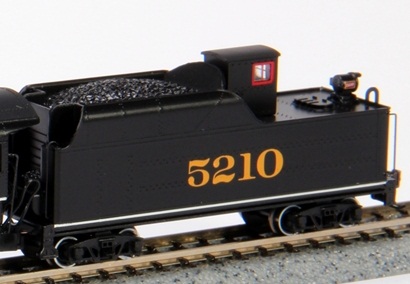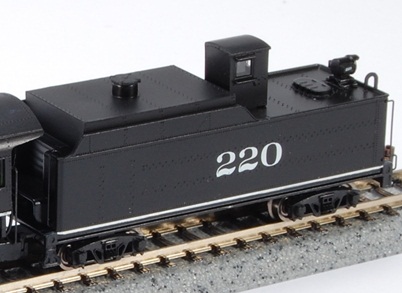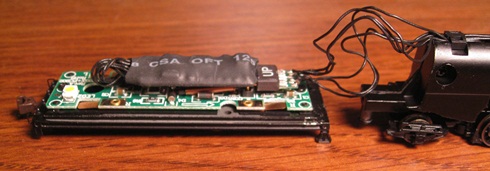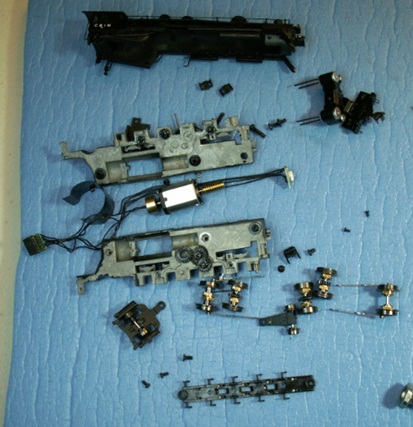

Introduced: 2011
These are exceptionally fine looking models that run quite well "as delivered". Unfortunately, they are bit disappointing in the longevity department, but more on that shortly.

The locomotive chassis is all-metal and split-frame (the boiler shell is metal as well). The flywheel-equipped motor is (presumably) the same closed-sided three-poler that Bachmann has been using in their other steamers of similar vintage. Six of the ten drivers provide pickup (the #2 and #4 driver pairs being equipped with traction tires). All eight tender wheels provide pickup as well. The pilot and trailing trucks are electrically neutral. Current is transferred from the engine to the tender by way of a pair of stiff wires on the drawbar. The center three driver pairs are geared, whereas the outer driver pairs are turned by the running gear. Apart from the brass worm, all gearing is plastic. All drivers are equipped with separate bearing blocks. The center driver pair's wheels lack flanges (presumably for improved tracking on curves).

A PC board with a directional headlight is mounted to the front of the chassis. Wires for motor control and lighting control are soldered to the lightboard and motor and run back to a connector that plugs into a socket on the tender PC board. An LED on the tender PC board provides illumination for the backup light (routed from the PC board to the backup light via a small piece of light-conducting plastic inside the tender shell). E-Z Mate automatic/magnetic couplers are mounted on the pilot and the tender shell (a Rapido-style coupler is included in the box should you want to go that route). Wheels are low-profile, so no problems on Code-55 rails.
This model comes with pretty much the same metal-chassis / plastic-shell USRA tender that Bachmann used on their heavy 4-8-2 model. Coal, oil and "doghouse" details vary by railroad, although all are equipped with a new backup light detail -


A DCC decoder is soldered in place on the tender PC board. Bachmann provides a couple of jumpers in the box, which presumably allow one to remove the decoder and operate the model using straight DC power. Unfortunately, there aren't any instructions showing where you're supposed to put said jumpers, so I guess you're on your own there.

And speaking of the decoder; for whatever reason, Bachmann likes to set the CV2 value (vstart) in their decoders to 10. Unfortunately, this makes for a rather high starting speed. Changing this setting to 0 makes a huge difference - allowing the locomotive to creep along almost slower than the eye can detect (in both DCC and DC modes).
Out of the box performance is absolutely perfect - smooth, quiet, and responsive at all throttle levels. Pickup is flawless (even through turnouts), the top-end speed is very reasonable, and (as mentioned above) it is capable of extremely fine slow speed control (once CV2 has been reprogrammed). No problems through narrow radius curves (right down to 9.75") and no problems with any of the wheels derailing. Mine can easily haul 30+ assorted freight cars on level track and about 15 cars on a curving 180-degree 2% grade (a real torture test for any engine).
On the downside, I did run into a couple of QC issues with mine (seemingly always a problem with Bachmann, especially on their first-run locomotives). First off, the screws on the driver bottom-plate were extremely loose, allowing the pilot truck way too much free play (and ultimately resulting in a lot of derailing). Fortunately, simply tightening the screws solved that problem. More vexing was the fact that a couple of the cranks came loose after a few minutes of operation (the two that slide on to a pin on the metal piece mounted over the right-side crosshead guide). Presumably said pin is supposed to have a widened end to keep the cranks from sliding off, but such was not the case with mine. Fortunately, reattaching the cranks and applying a tiny glob of white glue to the end of the pin took care of that problem.
QC annoyances aside, these models also have some rather dire issues with the driver axles that are not so easily addressed. The problem is that the axles are not seated firmly enough inside of their corresponding holes in the drivers, and over time they tend to want to work themselves loose and start slipping (thus allowing the drivers to get out of quarter and seize up). The non-geared #1 and #5 axles are particularly problematic. Now, one could (in theory) solve the problem by using some Threadlocker on the axles to keep them from slipping. However, this would be a non-trivial repair project and definitely not a simple "tweak". And despite Bachmann's so-called "lifetime warranty" on these things, don't expect them to be able to solve your locomotive's problems for you. When it comes to returned locomotives, they don't actually fix anything. Rather, they will just send you a replacement locomotive. And if they don't have your particular locomotive on hand (often the case), they will simply send you the closest thing they do have. So, unless you're comfortable repairing steam engines, I would steer clear of this one.
Here's what Bachmann has to say about their 2-10-2 -
Also known as Santa Fe class locomotives, these brutes were typically employed in drag freight service. Used throughout the United States until the late 1950s, our new N scale models are representative of the 2-10-2 as it appeared in the middle-to-late steam era.
Features -
- Dual Mode Decoder operates on analog and DCC
- DCC-equipped for speed, direction, and lighting
- Die-cast boiler
- Die-cast frame
- Die-cast cylinders
- Operating valve gears
- Tender style per prototype (with backup lights)
- Separately applied detail parts
- Operating E-Z Mate Mark II magnetic couplers
To remove the locomotive shell, first free the handrails and steps from the pilot. Then, simply unscrew the two screws at the back (below the cab) and the shell should lift right off (slide it forward a bit before lifting in order to clear the headlight PC board). To remove the tender shell, unscrew the two small screws on the bottom of the chassis as well as the rear truck screw. Then, free the four clips that hold the shell to the chassis. The shell should lift up and off at that point. And be careful about sticking any prying tools in the seam between the chassis and shell. As noted above, the tender chassis is metal (and easily scratched).
Grade: D (due to the axle slip issue)
Here's what happens when Victor Miranda gets his hands on a new steamer. Do not try this at home, kids!
